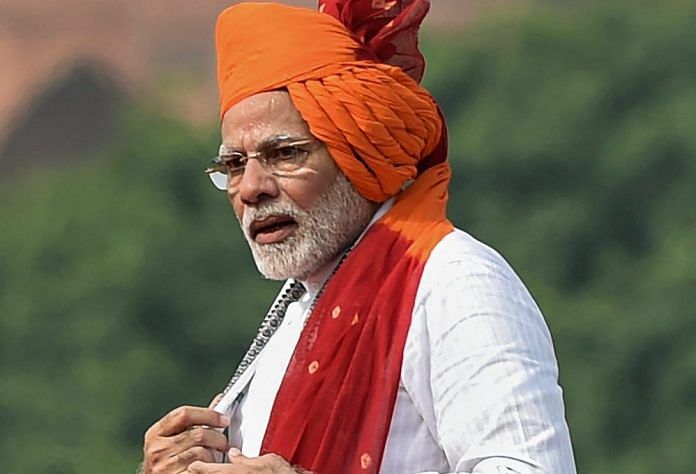The healthcare scheme that aims to cover 50 crore people across India will now be rolled out gradually from 25 September.
New Delhi: The Modi government’s ambitious healthcare scheme Ayushman Bharat was launched as ‘Pradhan Mantri Jan Arogya Abhiyaan’ Wednesday but it will not have a big-bang roll-out as originally expected.
Officials said the scale of implementation is too big and that the scheme needs to be launched on a pilot basis before its full-fledged implementation.
The government had planned to roll out the scheme, often referred to as ‘Modicare’, on Independence Day as yet another flagship welfare programme to benefit nearly 50 crore people across the country.
But Prime Minister Narendra Modi announced in his speech from the Red Fort that it would now be rolled out on 25 September, the birth anniversary of RSS-BJP ideologue Deendayal Upadhyaya.
“The scheme will provide an (insurance) cover of Rs 5 lakh per year to 50 crore individuals across income groups…we will be holding experiments in this sector for the next 6-7 weeks after which we will officially roll out the scheme,” Modi said.
“Few of you present here can understand the scale of this. This is the population of America, Canada and Mexico put together,” Modi said.
Echoing the PM’s views, CEO of the health scheme Indu Bhushan told ThePrint, “We need to roll this out slowly to ensure there are no glitches. However, we have started the pilot scheme in eight states, including Uttarakhand, Haryana, Chhattisgarh, Manipur and Himachal Pradesh.”
Officials and industry experts said the implementation of the programme, touted as the world’s largest government-funded healthcare scheme, faces several hurdles.
Also read: Ayushman Bharat explained: The scheme, the beneficiaries, the inspiration
Missing beneficiaries
The scheme aims to initially cover more than 10 crore ‘vulnerable’ families, as per the 2011 Socio-Economic and Caste Census (SECC) data, with an annual health cover of Rs 5 lakh per family per year.
Of the 10 crore, the government claims to have traced 95 per cent people. However, the Centre is yet to find the remaining 65 lakh families, tagged as ‘vulnerable’ in the 2011 census, most of whom are from the rural areas of Uttar Pradesh and Bihar.
In Uttar Pradesh, almost 23.61 lakh families are yet to be traced whereas in Bihar around 22 lakh families are missing. The remaining 19.45 lakh families are scattered across India.
“It has been a mammoth task as we are tracing families based on the 2011 census data. We need to understand that people are mobile and must have travelled to other parts of India in the past seven years,” Bhushan had said earlier.
Eight states are not on board
So far, 28 states and union territories have come on board for implementing the scheme. However, eight states, including Odisha and Kerala are yet to join.
“Many of these states are on the verge of signing. In these states, the necessary approvals have been done and now, we are just waiting for the official signing of the memorandum of understanding (MoU),” Bhushan had told ThePrint last week.
Wellness centers not yet ready
Under the scheme, about 25,000 wellness centres have been approved, of which, only 5,000 are operational now. A senior official from the health ministry said, “These wellness centres lack adequate number of doctors and nursing staff along with quality infrastructure. They were fast-tracked as several states agreed to partner with the Centre for the scheme.”
The government has also been trying to upgrade health sub-centres and primary health centres – which are currently focussed on maternal and child healthcare – into health and wellness centres which would provide a range of services, including the treatment for non-communicable diseases and chronic illnesses.
However, a shortage of funds is proving to be a major hurdle as the budget allocated for 1.5 lakh centres is a mere Rs 1,200 crore. The government had expected contributions from the private sector through CSR and also wants philanthropic institutions to adopt these centres.
According to the experts, the amount is grossly inadequate for setting up 1.5 lakh centres.
This amount of Rs 1,200 crore “would support only about 10,000 HWCs — less than 7 per cent of what has been projected”, wrote Abhay Shukla of Jan Swasthya Abhiyan and T. Sundararaman, a professor at Tata Institute of Social Sciences, in an article published in The Hindu.
Also read: Made in India, but Modicare owes a lot to China, South Korea and Thailand




The only alternative to financial inadequacies is to implement RASTRIYA GARIB SASHKTIKATAN YOJNA FUND which enables each of 11crore poor family to get minimum Rs 6LAC guarantee fund and RUPEES 5000 per month pension through a unique combination of CSR Ammendment and Black Money in Assets Transactions, Corporates voluntarily or mandatory be pursued to participate with 2%equity every five consecutive years totally 10%of entire corporates equity against economically viable sops such as EXEMPTION from CSR & Sovereign guarantee for part of GST/corporate tax paid.
All insurance premiums to be paid from fund, Attractive packages for attracting Private Investment in Cities, villages, towns initially say 5years be given.